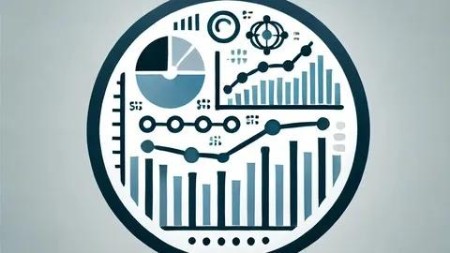Most Commented
Quantitative Analysis Of Data Using Spss V29




Description material

Quantitative Analysis Of Data Using Spss V29
Published 10/2024
MP4 | Video: h264, 1920x1080 | Audio: AAC, 44.1 KHz
Language: English | Size: 2.86 GB | Duration: 4h 18m
Quantitative Analysis, SPSS Software, Tests and Conclusions
What you'll learn
Explain the six SPSS windows and their specific uses.
Calculate the mean, sum, standard deviation, variance, and more.
Examine relationships using Scatter Plot and Scatter Plot Matrices.
Test for Normality and Homoscedasticity.
Explain numerical measures such as Central Location, Dispersion, Skewness, Kurtosis and Linearity.
Identify and differentiate between the different forms of outcomes.
Differentiate between the statistical types I and II errors.
Construct a multiple regression model, identify its elements and list its assumptions.
Learn to use the Ordinary Least Squares (OLS) regression method to estimate the coefficients.
Define the Standard Error of Estimates (SEE), explain its role in regression model and understand its visual representation.
Relate SEE to R-squared and the overall performance of the regression model.
Define ANOVA, explain its assumptions and significance in regression analysis, set its hypotheses, conduct ANOVA analysis using SPSS and explain its outcomes.
Formulate the null and alternative hypotheses.
Conduct a statistical T-test to assess and interpret the significance of the coefficients.
Define autocorrelation, identify its impact on regression models and test for autocorrelation using Durbin-Watson Test.
Explain the importance of forecasting time series data and perform a forecast seasonal time series data using SPSS V29.
Define MANOVA, explain its assumptions and significance in regression analysis, set its hypotheses, conduct MANOVA test using SPSS and explain its outcomes.
Generate different tests related to MANOVA such as: Box's M Test, Hotelling's T Squared, Pillai's Trace Test and Wilk's Lambda Test.
Formulate and test the hypotheses of all MANOVA tests using SPSS.
Compose and test the hypotheses for Levene's Test of homogeneity of variances.
Define Discriminant analysis and identify its variables, assumptions and hypotheses.
Test for Multivariate Normality, Equality of Covariances and Vectors of Means.
Perform a stepwise discriminant analysis and analyze its outcomes using the cross-validation method.
Define logistic regression, identify its variables and assumptions, compose its hypotheses, perform a stepwise logistic regression test and analyze its outputs.
Define the Principal Component Analysis (PCA), identify its key variables and assumptions, and conduct a PCA analysis following a detailed procedure on SPSS.
Define Factor Analysis (FA), identify its assumptions, variables and hypotheses, and conduct all FA tests and analyze their outcomes.
Define Cluster Analysis, identify its assumptions, variables and hypotheses, and conduct all FA tests and analyze their outcomes.
Apply all tests using practical exercises on SPSS
Requirements
No prerequisites are required. You will learn all steps in this course.
Description
This course offers a detailed exploration of quantitative data analysis using SPSS V29, a powerful software tool widely used in research fields such as social sciences, business, healthcare, and education. Designed for both beginners and intermediate users, the course covers essential statistical techniques and guides learners through the process of managing, analyzing, and interpreting quantitative data. Over 4 hours and 20 minutes of recorded lectures, accompanied by PDF notes for each session, will introduce you to core concepts in data analysis, such as:Data entry, management, and cleaning techniques using SPSS V29Descriptive statistics, including measures of central tendency and variabilityInferential statistics such as t-tests, ANOVA, regression analysis, and chi-square testsMultivariate analysis techniques, including factor analysis, discriminant analysis, and cluster analysisReporting and interpreting statistical outputs effectivelyUsing visual tools like graphs and charts for data presentationThe course also includes SPSS data files for hands-on practice, ensuring that students gain practical experience working with real datasets.Additionally, a quiz at the end of each lesson allows students to assess their understanding and apply the skills learned. By the end of this course, participants will be able to effectively use SPSS V29 to perform complex statistical analyses, create meaningful data visualizations, and report results professionally and clearly, equipping them with the tools needed for academic research or professional projects.
Overview
Section 1: Introduction & SPSS Basics
Lecture 1 Introduction
Lecture 2 Lesson 2.1 SPSS Basics
Section 2: Descriptive Statistics
Lecture 3 Descriptive Statistics
Lecture 4 Relationships
Lecture 5 Normality and Homoscedasticity
Lecture 6 Numerical Measures
Section 3: Hypotheses, Outcomes and Errors
Lecture 7 Null and Alternate Hypotheses
Lecture 8 Outcomes and Types of Errors
Section 4: Multiple Regression Model
Lecture 9 Multiple Regression Model and Assumptions
Lecture 10 Estimating the Coefficients
Lecture 11 Assessing the Model
Lecture 12 Assessing the Model: Analysis of Variance (ANOVA)
Lecture 13 Testing and Interpreting the Coeficients
Lecture 14 Correlation of Errors: Durbin Watson Test
Lecture 15 Forecasting Seasonal Time Series
Section 5: Multivariate Analysis of Variance (MANOVA)
Lecture 16 Multivariate Analysis of Variance (MANOVA)
Section 6: Discriminant Analysis (DA)
Lecture 17 Discriminant Analysis in Statistics
Section 7: Logistic Regression (LR)
Lecture 18 Understanding Logistic Regression
Section 8: Principal Component Analysis (PCA)
Lecture 19 Principal Component Analysis (PCA)
Section 9: Factor Analysis
Lecture 20 Factor Analysis (FA)
Section 10: Cluster Analysis (CA)
Lecture 21 Cluster Analysis (CA)
Graduate and Postgraduate students who are engaged in writing their thesis or dissertation which is based on a quantitative analysis of data.,Beginner researchers who require a tool to analyze their findings.

Fikper
https://fikper.com/5YV85EjtUs/Quantitative.Analysis.of.Data.Using.SPSS.V29.part1.rar.html
https://fikper.com/77oFTCmcvZ/Quantitative.Analysis.of.Data.Using.SPSS.V29.part2.rar.html
FileAxa
https://fileaxa.com/szddwmuz7wqe/Quantitative.Analysis.of.Data.Using.SPSS.V29.part1.rar
https://fileaxa.com/rtk3jul7x3gy/Quantitative.Analysis.of.Data.Using.SPSS.V29.part2.rar
RapidGator
https://rapidgator.net/file/e9ccc2ddc68f2f25dce2e82da1ed80cb/Quantitative.Analysis.of.Data.Using.SPSS.V29.part1.rar
https://rapidgator.net/file/af08c1f3474dddb1e6eccfc286e501ca/Quantitative.Analysis.of.Data.Using.SPSS.V29.part2.rar
FileStore
TurboBit
https://turbobit.net/6sdpu0npmi2v/Quantitative.Analysis.of.Data.Using.SPSS.V29.part1.rar.html
https://turbobit.net/ykg5tqrjq6jf/Quantitative.Analysis.of.Data.Using.SPSS.V29.part2.rar.html
Join to our telegram Group
Information
Users of Guests are not allowed to comment this publication.
Users of Guests are not allowed to comment this publication.
Choose Site Language
Recommended news
Commented



![eM Client Pro 9.2.1735 Multilingual [Updated]](https://pikky.net/medium/wXgc.png)






![Movavi Video Editor 24.0.2.0 Multilingual [ Updated]](https://pikky.net/medium/qhrc.png)

